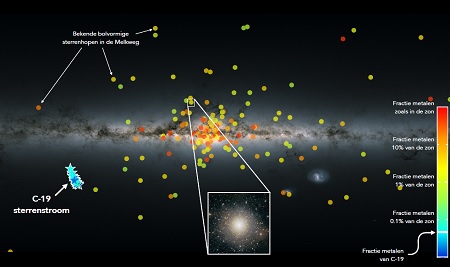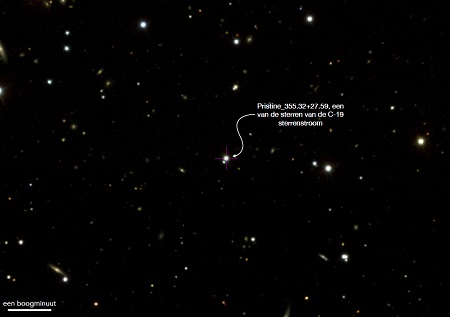Extreem metaalarme sterrenstroom in de Melkweg ontdekt
Een internationaal onderzoeksteam, met onder anderen Else Starkenburg van de Rijksuniversiteit Groningen, heeft de overblijfselen ontdekt van een sterrenhoop met sterren die uitzonderlijk weinig zware elementen bevatten. Niet eerder werd een sterrenhoop ontdekt met zo’n laag metaalgehalte. Volgens sommige theorieën zouden zulke sterrenhopen helemaal niet kunnen zijn gevormd, volgens andere zouden ze allemaal al verdwenen moeten zijn. Het onderzoek is deze week gepubliceerd in het wetenschappelijke tijdschrift Nature.
Opeenvolgende generaties sterren verrijken hun omgeving met zware elementen (in de sterrenkunde doorgaans ‘metalen’ genoemd). Iedere nieuwe generatie bevat daardoor meer metalen. En oudere sterren bevatten juist een lagere fractie metalen. De nu ontdekte sterrenhoop is waarschijnlijk in het zeer vroege heelal gevormd uit sterren van een heel oude generatie. De sterrenhoop is daarmee een opmerkelijk reliek uit de tijd dat de allereerste sterstructuren zich vormden.

Sterrenstroom
Om die vroegste structuren in het heelal te bestuderen, kunnen astronomen kijken naar de verste sterrenstelsels. Maar sterrenkundigen kijken ook naar de oudste structuren in de buitenste delen van onze eigen Melkweg, die daar vanuit kleinere sterrenstelsels zijn terechtgekomen. De nieuw ontdekte sterrenhoop is op die manier binnengekomen maar heeft zijn sterren langzaam verloren tijdens zijn reis door de Melkweg. Door dit proces is van de sterrenhoop alleen een sterrenstroom aan de hemel achtergebleven.
'Deze ontdekking illustreert prachtig wat we kunnen leren als we astronomen met verschillende expertises van over de hele wereld samenbrengen', zegt RUG-sterrenkundige Else Starkenburg. 'Ons team heeft deze opmerkelijke sterrenhoop ontdekt met gegevens van de ruimtetelescoop Gaia in combinatie met waarnemingen van meerdere telescopen op aarde.'

Verrassend
Het onderzoeksteam gebruikte de ongekend gedetailleerde kaart van de locatie en beweging van sterren, die is gemaakt op basis van data van de Gaia-satelliet, in 2013 gelanceerd door het Europese Ruimteagentschap ESA. Ze gebruikten daarbij een nieuw algoritme om de zeldzame groeperingen van sterren te isoleren die gezamenlijk door de Melkweg bewegen. Eén van de structuren die ze op deze manier ontdekten, was een nieuwe kandidaat-sterrenstroom, die het team ‘C-19’ noemde.
Aanvullende informatie kwam vanuit de Pristine-survey, geïnitieerd door Starkenburg en uitgevoerd met de Canada-France-Hawaii-telescoop op Hawaï. Pristine brengt de hemel in kaart om systematisch de relatieve hoeveelheid zware elementen in miljoenen sterren te meten. De combinatie van deze twee onderzoeken bracht het verrassende nieuws dat C-19 uitsluitend sterren bevat met een extreem lage fractie zware elementen.

Ver verleden
Vervolgwaarnemingen met de Gemini-North-telescoop op Hawaï en de Gran Telescopio Canarias op La Palma onthulden een nog gedetailleerder beeld van de zware elementen in deze sterren. Ze bevestigden de classificatie van uit elkaar getrokken sterrenhoop en vonden een nauwkeurigere waarde voor de uitzonderlijk lage fracties van zware elementen in zijn sterren: slechts 0,04% van de hoeveelheid in onze zon, veel minder dan in elke andere bekende groep van sterren in het universum.
'Dit overblijfsel uit het verre verleden geeft ons een belangrijk beeld van stervorming in het piepjonge universum en de allereerste opbouw van sterstructuren', zegt eerste auteur Nicolas Martin (Sterrenkundig Observatorium van Straatsburg, Frankrijk). 'Onze steeds betere Melkwegkaarten van de Gaia-satelliet, gecombineerd met onderzoeken zoals Pristine zullen hopelijk tot meer van dit soort uitzonderlijke ontdekkingen leiden.'
Tekst: persbericht NOVA
Referentie: Nicolas F. Martin, Kim A. Venn, David S. Aguado, Else Starkenburg, Jonay I. Gonzalez Hernandez, Rodrigo A. Ibata, Piercarlo Bonifacio, Elisabetta Caffau, Federico Sestito, Anke Arentsen, Carlos Allende Prieto, Raymond G. Carlberg, Sebastien Fabbro, Morgan Fouesneau, Vanessa Hill, Pascale Jablonka, Georges Kordopatis, Carmela Lardo, Khyati Malhan, Lyudmila I. Mashonkina, AlanW. McConnachie, Julio F. Navarro, Ruben Sanchez Janssen, Guillaume F. Thomas, Zhen Yuan, Alessio Mucciarelli: A stellar stream remnant of a globular cluster below the metallicity floor. Nature, 6 januari 2022.
Meer nieuws
-
19 december 2025
Mariano Méndez ontvangt Argentijnse RAÍCES-prijs
-
18 december 2025
Waarom innoveren, en voor wie?
-
17 december 2025
Ben Feringa wint Feynmanprijs

